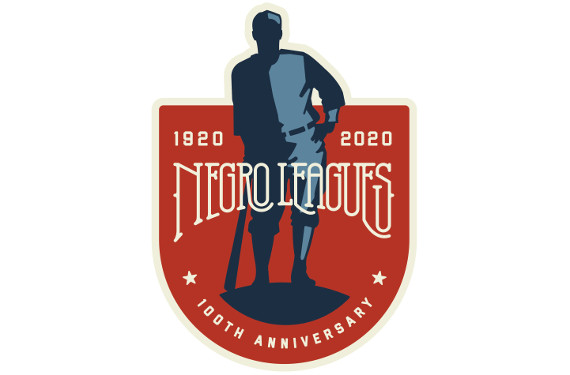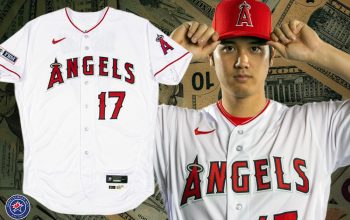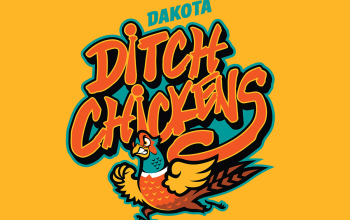The Negro Leagues Baseball Museum in Kansas City is taking the lead in commemorating the 100th anniversary of the founding of the Negro Leagues, which took place February 13, 1920. The museum took the occasion of the 99th anniversary of the Negro Leagues earlier this month to unveil its centennial logo and announce preliminary plans for festivities next year.
The logo, which was designed free of charge by Adam Rolf of the Kansas City–based firm Global Prairie, includes the silhouette of a player who is not meant to represent one specific individual, though, according to Bob Kendrick, president of the Negro Leagues Baseball Museum, it draws heavily on the likeness of Hall of Famer Raleigh “Biz” Mackey.
“We wanted this logo to convey strength, we wanted this logo to convey pride, because those are the things that are the hallmark of the Negro Leagues,” Kendrick said. “I think the designer did a wonderful job of capturing what the Negro Leagues represented.”

Through its commemoration of this anniversary, the museum hopes to bring the story of the Negro Leagues to the larger baseball community—not just the story of the integration of baseball but the critically important role the Negro Leagues played prior to the integration of the sport.
“It’s one of the most significant things to happen in the annals of American history, and a lot of people don’t know that,” Kendrick said. “It’s our job to help people understand why the Negro Leagues were so important and what this milestone anniversary really means in our country’s history.”
Many visitors to the museum, which I had the pleasure of visiting in 2015, are learning the important history of the heyday of the Negro Leagues for the first time. The names of players and even the teams are unfamiliar to most because, according to Kendrick, to some, if it didn’t happen in the Major Leagues, it didn’t happen at all.
But the Negro Leagues were about more than players or teams or even the sport itself.
“This is a story that is about economic empowerment,” Kendrick said. “This is a story of unprecedented levels of leadership that emerged in the African American community as a result of these owners and these teams and all these other positions that came along with the infrastructure of black baseball.”
It’s impossible to talk about the history of the Negro Leagues—or the necessity of their existence—without talking about the larger history of race relations in the United States.
“What segregation did was it mandated ownership, and so that prevalence of black ownership will likely never be seen again,” Kendrick said. “Wherever you had successful black baseball, you had thriving black economies. There is a direct parallel between the rise and fall of the Negro Leagues with the rise and fall of black economies in this country.”
The desegregation of baseball, obviously, is one of the most important moments of social progress that our nation has seen, and that is a large part of the story the museum conveys.
“Jackie Robinson being hand-picked from the Kansas City Monarchs to break baseball’s six-decade-long, self-imposed color barrier, not only changed our game, it changed our country,” Kendrick said. “That was the beginning of the Civil Rights movement in our country.”
As part of the larger story of America, the integration of baseball has become part of the national consciousness. Jackie Robinson’s number is retired throughout Major League Baseball, and his legacy is honored on the fields throughout the league every year.
“It was good for the soul of our country,” Kendrick said. “It moved us in ways socially in which we never ever dreamed possible.”
But progress comes with a price, and the demise of the Negro Leagues, which at their height were the third-largest African American–owned business in the nation, is bittersweet.
“I’m not sure the African American community realized what it was losing when it lost the Negro Leagues,” Kendrick said. “It was such an important catalyst in sparking economic opportunities within the African American community at the time.”
Because there are so many factors at play—economic, cultural, social—the story of the Negro Leagues is vitally important not just for fans of the sport, but for anyone who wants to understand America. That said, for baseball fans in particular, the museum is a special place that evokes nostalgia even in the context of such a difficult and painful chapter in our country’s history.
“Baseball is merely a premise for a far-more grandiose story,” Kendrick said, “but what I love about this is, it is still just a tiny part of the great story of the game of baseball.”
The museum hopes to work on the commemoration with Major League Baseball, which Kendrick describes as a “great partner.” The logic behind such a partnership is evident.
“The Negro Leagues made Major League Baseball better, and that is undeniable,” Kendrick said. “Even though these players were kept out of the major leagues, once the door opened, the Negro Leagues really helped make Major League Baseball major. I don’t think Major League Baseball became major until after 1947, when you allowed all the great players to take the field, so it seems to me it would only be natural that there would be some sort of partnership in this effort.”
The centennial festivities will kick off February 13, 2020, with an exhibit at the museum featuring 200 paintings by baseball artist Graig Kreindler, and culminate with a gala November 14, 2020. Plans for further events throughout the nation are still in development.






